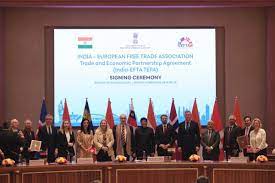
India-EFTA Group Agreement
India-EFTA Group Agreement
GS-2: International Relations
(UPSC/State PSC)
Important for Prelims:
EFTA Group, Global Trade Research Initiative (GTRI), India TEPA.
Important for Main Exam:
About EFTA, Implications of EFTA-India TEPA Agreement, Conclusion.
11/03/2024
Why in news:
Recently, India and the EFTA group signed a bilateral free trade agreement to promote investment and two-way trade in goods and services.
Other points related to EFTA agreement:
- This is India's first FTA with four European countries in which India has expressed its commitment to realize the potential in investment and employment.
- EFTA group countries are considering investing in joint ventures in sectors such as pharmaceuticals, especially medical devices, certain chemicals, food processing and engineering products.
- Under this, the EFTA group has committed to invest $ 100 billion in India in the next 15 years.
- According to the economic research institute ‘Global Trade Research Initiative (GTRI)’, India has removed duties on Switzerland-based products in the last 10 years. It is noteworthy that some of the famous watch brands of Switzerland are Rolex, Omega and Cartier. Nestle, a Swiss brand, is a leading company and chocolate manufacturer in the Indian FMCG (household goods of daily use) market. It is the third largest listed company in the Indian FMCG sector.
Significance:
- This agreement will help in increasing investment flow, employment generation and economic growth between the two countries.
- This will give domestic customers access to products from countries in this group at lower prices.
About EFTA:
- Intergovernmental Organization: The European Free Trade Association is an intergovernmental organization established to promote free trade and economic cooperation between its members within Europe and globally.
- Objective: Deeper economic integration among its members, including a common customs union.
- Member States: It has four member states: Iceland, Liechtenstein, Norway and Switzerland.
- All of these countries are open, competitive economies committed to progressive liberalization of trade in the multinational sector as well as free trade agreements.
Historical Background of EFTA:
- EFTA was established by the Stockholm Convention in 1960 as an alternative to the European Economic Community (EEC), the precursor to the European Union (EU).
- Consultative Bodies: The EFTA Parliamentary Committee (PC) and the EFTA Consultative Committee (CC) are two important bodies of the EFTA Council.
About EFTA-India TEPA:
- TEPA stands for Trade and Economic Partnership Agreement.
- Objective: It aims to boost trade between the two regions by reducing tariffs on goods and services as well as promoting investment and cooperation.
- EFTA Council: This is the supreme governing body of EFTA. The Council normally meets eight times a year at the ambassadorial level and twice a year at the ministerial level.
- EFTA Secretariat: Headquartered in Geneva, it deals with the management and negotiation of free trade agreements with non-EU countries, and provides assistance to the EFTA Council.
Implications of EFTA-India TEPA Agreement:
- Increase in trade: Reduction in tariffs and quotas on goods and services is likely to significantly increase trade between India and EFTA countries.
- Investment Opportunities: This agreement can encourage more Foreign Direct Investment (FDI) into India from EFTA countries which will lead to creation of new businesses, technology transfer and infrastructure development in India.
- The proposed free trade agreement is expected to lead to an investment flow of $100 billion from the Group of Four countries into India over the next 15 years, creating an estimated one million jobs.
- Improved efficiency: Streamlined customs procedures and rules can make trade between India and EFTA countries more efficient and less time-consuming, benefiting businesses on both sides.
- Reducing trade deficit: The trade agreement with EFTA is also likely to reduce India's huge trade deficit with the bloc.
- India's exports to the EFTA bloc stood at $1.87 billion in 2023, with chemicals, pharmaceuticals, apparel and items such as pearls and precious and semi-precious stones dominating the export base.
- On the other hand, it imported goods worth $20.45 billion from EFTA in 2023, including pearls, precious or semi-precious stones, precious metals and coins worth $16.7 billion.
- India FTA negotiations with other countries: The signing of the India-FTA TEPA is likely to give a boost to India's ongoing FTA negotiations with other partners such as the EU and the UK.
Conclusion:
- India has been working on a Trade and Economic Partnership Agreement (TEPA) with EFTA. TEPA will accelerate “Make in India” and “Self-reliant India” by encouraging domestic manufacturing in sectors such as infrastructure and connectivity, manufacturing, machinery, pharmaceuticals, chemicals, food processing, transport and logistics, banking and financial services and insurance.
Source: The Hindu
---------------------------------------
Mains Question:
What is EFTA? Discuss the implications of the EFTA-India TEPA agreement.